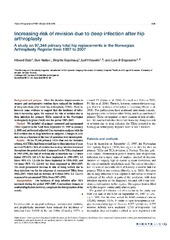| dc.contributor.author | Dale, Håvard | en_US |
| dc.contributor.author | Hallan, Geir | en_US |
| dc.contributor.author | Espehaug, Birgitte | en_US |
| dc.contributor.author | Havelin, Leif Ivar | en_US |
| dc.contributor.author | Engesæter, Lars B. | en_US |
| dc.date.accessioned | 2013-10-08T15:23:14Z | |
| dc.date.available | 2013-10-08T15:23:14Z | |
| dc.date.issued | 2009-12 | eng |
| dc.Published | Acta Orthopaedica 80(6): 639-645 | eng |
| dc.identifier.issn | 1745-3674 | |
| dc.identifier.uri | https://hdl.handle.net/1956/7371 | |
| dc.description.abstract | Background and purpose: Over the decades, improvements in surgery and perioperative routines have reduced the incidence of deep infections after total hip arthroplasty (THA). There is, however, some evidence to suggest that the incidence of infection is increasing again. We assessed the risk of revision due to deep infection for primary THAs reported to the Norwegian Arthroplasty Register (NAR) over the period 1987-2007. Method: We included all primary cemented and uncemented THAs reported to the NAR from September 15, 1987 to January 1, 2008 and performed adjusted Cox regression analyses with the first revision due to deep infection as endpoint. Changes in revision rate as a function of the year of operation were investigated. Results: Of the 97,344 primary THAs that met the inclusion criteria, 614 THAs had been revised due to deep infection (S-year survivaI 99.46%). Risk of revision due to deep infection increased throughout the period studied. Compared to the THAs implanted in 1987-1992, the risk of revision due to infection was 1.3 times higher (95%CI: 1.0-1.7) for those implanted in 1993-1997, 1.5 times (95% Cl: 1.2-2.0) for those implanted in 1998-2002, and 3.0 times (95% Cl: 2.2-4.0) for those implanted in 2003-2007. The most pronounced increase in risk of being revised due to deep infection was for the subgroup of uncemented THAs from 2003-2007, which had an increase of 5 times (95% Cl: 2.6-11) compared to uncemented THAs from 1987-1992. Interpretation: The incidence of deep infection after THA increased during the period 1987-2007. Concomitant changes in confounding factors, however, complicate the interpretation of the results. | en_US |
| dc.language.iso | eng | eng |
| dc.publisher | Informa Healthcare | eng |
| dc.relation.ispartof | <a href="http://hdl.handle.net/1956/7388" target="blank">Infection after primary hip arthroplasty. Epidemiology, time trends and risk factors in data from national health registers</a> | eng |
| dc.rights | Attribution-NonCommercial CC BY-NC | eng |
| dc.rights.uri | http://creativecommons.org/licenses/by-nc/3.0/ | eng |
| dc.title | Increasing risk of revision due to deep infection after hip arthroplasty. A study on 97,344 primary total hip replacements in the Norwegian Arthroplasty Register from 1987 to 2007 | en_US |
| dc.type | Peer reviewed | |
| dc.type | Journal article | |
| dc.description.version | publishedVersion | en_US |
| dc.rights.holder | Copyright 2009 Informa Healthcare. This article is distributed under the terms of the Creative Commons Attribution Noncommercial License which permits any noncommercial use, distribution, and reproduction in any medium, provided the source is credited. | |
| dc.identifier.doi | https://doi.org/10.3109/17453670903506658 | |
| dc.identifier.cristin | 342905 | |
| dc.source.journal | Acta Orthopaedica | |
| dc.source.40 | 80 | |
| dc.source.14 | 6 | |
| dc.source.pagenumber | 639-645 | |

